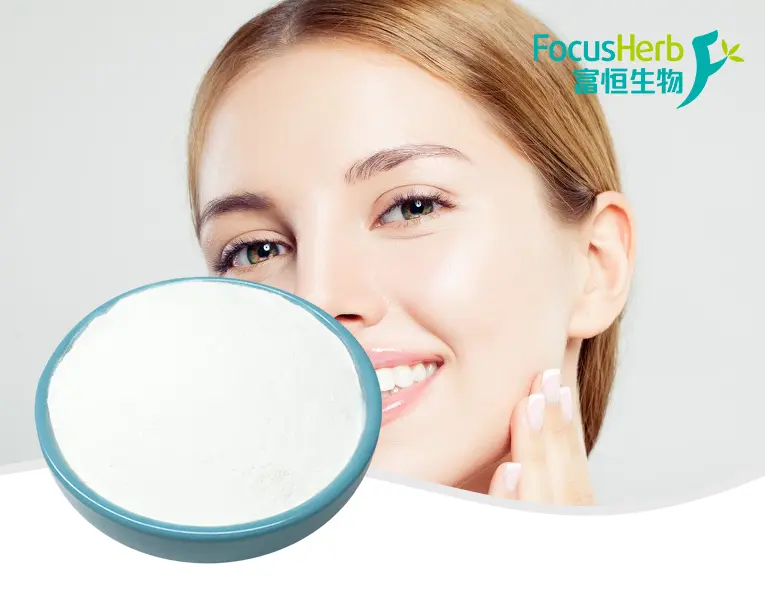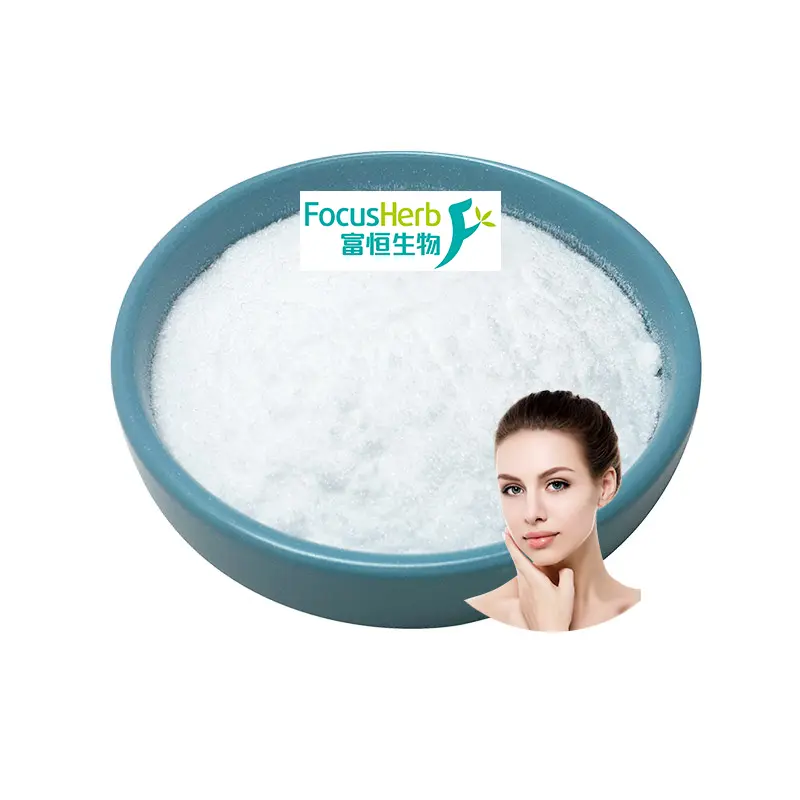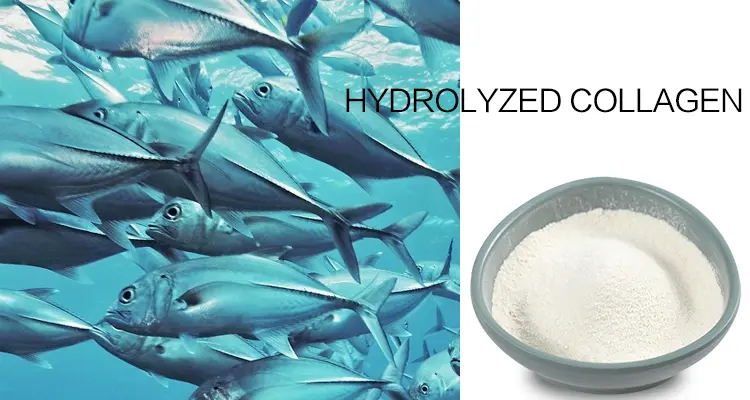Hyaluronic Acid is the sodium salt form of hyaluronic acid. Chemically, hyaluronic acid is a glycosaminoglycan composed of N-acetylglucuronic acid as its sugar moiety, a high-molecular-weight compound. Hyaluronic Acid is formed when the carboxyl group of hyaluronic acid dissociates and combines with sodium ions under appropriate pH conditions or physiological conditions, resulting in a more stable sodium salt. It is an intrinsic component of the human body and is non-species specific. It is widely present in tissues and organs such as the placenta, amniotic fluid, lens, articular cartilage, and the dermis of the skin. It plays a key role in the cytoplasm and intercellular matrix, not only lubricating and nourishing the cells and organelles contained therein, but also providing the microenvironment necessary for cellular metabolism.
Hyaluronic Acid performs important functions in various tissues of the human body. In the skin, it is present in large quantities in the dermis, playing a crucial role in maintaining skin hydration, elasticity, and radiance. As we age, the Hyaluronic Acid content in the skin gradually decreases, which is one of the important reasons for aging phenomena such as dryness, wrinkles, and sagging of the skin. In joints, it is the main component of synovial fluid, providing lubrication and cushioning for the joints, reducing friction between cartilages during joint movement, just like adding high-quality lubricating oil to machine parts, allowing joints to move freely, while also promoting the healing and regeneration of articular cartilage. In the eyes, Hyaluronic Acid is an important component of the vitreous body and plays an indispensable role in maintaining the stability of the intraocular structure and the normal physiological function of the eye.
 Unique Chemical Structure and Properties
Unique Chemical Structure and Properties
Hyaluronic Acid has a unique chemical structure. It consists of two disaccharide units, D-glucuronic acid and N-acetyl-D-glucosamine, linked by alternating β-1,3 and β-1,4 glycosidic bonds, forming a repeating linear macromolecular polysaccharide. This structure resembles a long necklace made of two different colored beads strung together according to a specific pattern. Each disaccharide unit in this “necklace” is a “bead assembly,” and their neat arrangement forms the basic skeleton of Hyaluronic Acid.
The presence of numerous hydrophilic groups is a notable characteristic of Hyaluronic Acid. Numerous hydrophilic groups, such as carboxyl (-COOH) and hydroxyl (-OH), are distributed throughout its molecular chain. These groups act like tiny magnets with a strong attraction to water, tightly connecting to water molecules through hydrogen bonds. Hydrogen bonds act like invisible hooks, tightly linking Hyaluronic Acid molecules to water molecules. This makes Hyaluronic Acid highly water-soluble, allowing it to dissolve easily in water and form a uniform solution. It also has a strong hygroscopicity. In low relative humidity environments, it can efficiently capture water molecules from the surrounding air, absorbing hundreds or even thousands of times its own weight in water, much like a dry sponge quickly swells up when placed in water. Its moisture absorption capacity reaches its highest at 33% relative humidity, while it is relatively low at high humidity levels of 75%. This property allows it to adapt well to the moisturizing needs of varying humidity environments.
Outstanding Performance in Beauty and Skincare

Superior Moisturizing, a Skin “Water Reservoir”
Hyaluronic Acid is considered one of nature’s most potent moisturizing substances. It acts as a highly efficient moisture collector, capable of absorbing hundreds or even thousands of times its own weight in water. When applied to the skin, skincare products containing Hyaluronic Acid quickly build a water-rich film in the stratum corneum, acting like a “micro-reservoir” that locks moisture firmly within the skin’s surface. During the dry autumn and winter seasons, when humidity is low, skin is prone to moisture loss. This thin film acts like an invisible moisturizing shield, slowing evaporation and keeping skin hydrated. In the high humidity of summer, it absorbs excess moisture from the environment like a sponge, replenishing it and maintaining the skin’s water-oil balance.
Furthermore, low-molecular-weight Hyaluronic Acid possesses enhanced penetration, penetrating deep into the epidermis and even the dermis. Within the skin, it actively increases the moisture content between skin cells, providing sufficient water to support cellular metabolism, like a spring infusing dry land, revitalizing skin cells and maintaining a hydrated, plump appearance. This deep, hydrating effect, from within, effectively improves dryness and roughness, leaving skin softer, smoother, and as delicate as a peeled egg.
Repairing the barrier and strengthening defenses
The skin barrier is like a strong wall in the human body, primarily composed of stratum corneum cells and intercellular lipids, and it shoulders the important task of defending against the invasion of harmful external substances. However, when the skin is exposed to external stimuli such as strong UV radiation, chemical exposure, and excessive cleansing, this barrier can easily become damaged, impairing the skin’s barrier function and leading to a series of problems such as dryness, sensitivity, and itching.
At this point, Hyaluronic Acid acts like a diligent “repairman,” quickly taking effect. It cleverly fills the gaps between damaged keratinocytes, increasing intercellular adhesion, much like cement filling the cracks in a wall, allowing keratinocytes to align tightly and restore the integrity of the skin’s barrier. Furthermore, Hyaluronic Acid actively promotes the proliferation and differentiation of skin cells, accelerating the production of new cells to replace damaged ones, much like recruiting more construction workers to speed up the repair of the wall. Furthermore, it works synergistically with other components in the skin, such as ceramides, to strengthen the skin’s barrier function. Ceramides are an important component of intercellular lipids in the skin. Working together with Hyaluronic Acid, they further reduce the penetration of harmful external substances, reduce skin sensitivity, and promote healthier and stronger skin.
Improves Elasticity and Fights Aging
With the passage of time and the influence of environmental factors, the collagen and elastic fibers in the skin gradually degrade and degenerate, much like an aging rubber band loses its elasticity. This leads to sagging and wrinkles, which are key signs of skin aging.
Hyaluronic Acid plays a key role in combating skin aging. It interacts closely with collagen and elastic fibers in the skin. In the dermis, Hyaluronic Acid provides sufficient moisture to support collagen and elastic fibers, injecting them with vitality, maintaining their elasticity and resilience, and maintaining the stable structure of skin tissue. Hyaluronic Acid also stimulates skin cell metabolism and promotes collagen synthesis, replenishing lost collagen and further enhancing skin elasticity and firmness. Long-term use of skincare products containing Hyaluronic Acid can alleviate skin sagging and wrinkles to a certain extent, making the skin firmer and more radiant, restoring a youthful glow.
Important Role in the Medical Field

A Powerful Aid in Ophthalmic Surgery
Hyaluronic Acid plays a crucial role in ophthalmic surgery, often used as a viscoelastic agent, providing strong support for smooth surgical procedures. During cataract surgery, when surgeons need to remove the cloudy lens and implant an intraocular lens, Hyaluronic Acid’s role becomes particularly prominent. Like an “invisible guard” during surgery, Hyaluronic Acid, once injected into the eye, cleverly fills the surgical area, forming a protective layer with a certain degree of viscosity and elasticity. This protective layer not only effectively prevents surgical instruments from directly contacting and damaging delicate intraocular tissues such as the corneal endothelium and lens during operation, but also maintains the stability of the intraocular space, creating a stable “operating platform” for surgery. This allows surgeons to precisely perform procedures such as implanting the intraocular lens in a stable environment, significantly improving the success rate and safety of the surgery. Statistics show that using Hyaluronic Acid as a viscoelastic agent in cataract surgery significantly reduces the incidence of postoperative complications such as corneal edema, and improves visual recovery.
Hyaluronic Acid also plays a key role in glaucoma surgery. The goal of glaucoma surgery is to lower intraocular pressure and improve aqueous humor circulation. During surgery, Hyaluronic Acid helps surgeons better separate tissues and minimize damage to intraocular structures. It can fill critical areas such as the anterior chamber angle, maintaining patency and promoting aqueous humor drainage, thereby effectively lowering intraocular pressure and protecting the patient’s visual function.
An Effective Solution for Joint Diseases
Hyaluronic Acid is an effective solution for patients with joint diseases such as osteoarthritis. With aging, excessive exercise, or trauma, joint cartilage becomes susceptible to damage, and the quality and quantity of synovial fluid decreases, leading to symptoms such as joint pain, swelling, and limited mobility. Intra-articular injection of Hyaluronic Acid acts as a lubricant and repair agent for damaged joints. Hyaluronic Acid significantly increases the viscoelasticity of synovial fluid, enabling it to better lubricate and reduce friction between articular cartilage. It acts like lubricating rusty machine parts, allowing joints to move more smoothly and effectively alleviating joint pain and discomfort. It also promotes the anabolism of articular chondrocytes, providing them with essential nutrients and stimulating their production of cartilage matrix components such as collagen and proteoglycans, thereby aiding the repair and regeneration of damaged articular cartilage. Hyaluronic Acid also exhibits anti-inflammatory properties, inhibiting the release of inflammatory factors, reducing local joint inflammation, and alleviating symptoms such as joint swelling. Clinical studies have shown that for patients with mild to moderate osteoarthritis, regular intra-articular injections of Hyaluronic Acid significantly improve joint pain, swelling, and joint mobility within a few weeks.
Medical Device Lubrication and Drug Carriers
In the medical device field, the lubricating properties of Hyaluronic Acid make it an ideal lubricant. During urethral insertion, if the surface of a urinary catheter is not well lubricated, it can easily damage the urethral mucosa, causing pain and discomfort to the patient, and even potentially leading to complications such as urinary tract infection. Coating the catheter with Hyaluronic Acid can significantly reduce friction between the catheter and the urethral mucosa, making insertion smoother and minimizing damage and discomfort to urethral tissue. Hyaluronic Acid also provides a similar lubricating effect during endoscopic procedures such as gastroscopy and colonoscopy, allowing the endoscope to pass more smoothly through the digestive tract and reducing patient pain during the examination.
Hyaluronic Acid’s unique structure makes it suitable for use as a drug carrier, facilitating precise and efficient drug delivery. It can physically or chemically encapsulate drug molecules, like a “cloak” of invisibility. Once the drug is delivered to the affected area, the Hyaluronic Acid gradually degrades and slowly releases the drug molecules, ensuring sustained action, prolonging its duration, and enhancing its efficacy. In some topically administered drug preparations, Hyaluronic Acid can precisely deliver drugs to the site of disease. For example, when Hyaluronic Acid is added to eye drops for the treatment of eye diseases, it can carry drugs and better adhere to the ocular surface, thereby increasing the drug’s residence time and absorption efficiency in the eye, while reducing the drug’s side effects on normal tissues.
Market Status and Future Outlook
 Market Competition Landscape
Market Competition Landscape
The global Hyaluronic Acid market is polarized. In the high-end market, leading companies focused on pharmaceutical-grade standards hold a significant position. These companies have built a strong technological moat through innovative technology and a deep focus. Companies like HTL, with their sophisticated expertise in pharmaceutical-grade Hyaluronic Acid, have established significant technological barriers in high-end medical fields like ophthalmology and orthopedics. While their product quality is reliable, their high pricing has deterred many downstream companies. Kewpie, a non-Chinese raw material manufacturer, occupies a key position in the global high-end medical aesthetics supply chain for its injectable-grade hyaluronic acid raw materials. However, its localization process has lagged, resulting in a low overall penetration rate in the Chinese market.
In China, Bloomage Biotechnology, positioned as a leading player in the entire industry chain, continues to lead the Hyaluronic Acid market. It is the world’s largest supplier of hyaluronic acid raw materials, with four major business segments encompassing active ingredients, medical devices, functional skincare products, and functional foods. While its total hyaluronic acid production capacity ranks first globally at 770 tons per year, its pharmaceutical-grade Hyaluronic Acid production capacity is only 20 tons. In recent years, Bloomage Biopharma has faced bottlenecks in its transformation, with R&D investment in Hyaluronic Acid raw materials gradually decreasing and its expansion into new sectors such as recombinant collagen being slow. Its “big and comprehensive” model is facing challenges from innovators in niche areas. Focus Biopharma (Shandong Focus Freda Biopharma Co., Ltd.) is a high-tech enterprise specializing in the production of Hyaluronic Acid raw materials. With a production capacity of 420 tons, it primarily supplies non-pharmaceutical-grade raw materials, while pharmaceutical-grade products are still in the market development phase. Its qualification system primarily covers the mid- and low-end markets. Zhongshan Bio has taken a path of “vertical development + technological innovation.” Through its groundbreaking aseptic production process, it has established a technological advantage and focused on the high-end pharmaceutical-grade market. It boasts significant advantages in terms of production capacity, product quality, and regulatory compliance for pharmaceutical-grade Hyaluronic Acid. It is one of the few domestic companies to hold both GMP and CEP certificates for Hyaluronic Acid.
In the low-end market, numerous suppliers are price-driven, leveraging their scale advantages to compete on low prices. While these companies have established comprehensive supply chains, they can meet certain market demands, but product quality varies widely, making it difficult to meet high-end demands such as innovative clinical applications. This can also easily lead to conflicts of interest and disorderly competition in the market.
Development Trend Forecast
With the continuous advancement of technology and evolving market demand, the expansion of Hyaluronic Acid across various application areas is becoming increasingly clear. In the pharmaceutical field, in addition to existing applications in ophthalmology and orthopedics, research on Hyaluronic Acid in tissue engineering and drug sustained-release systems is also deepening. For example, in tissue engineering, Hyaluronic Acid can be used as a scaffold for cell culture, providing a suitable microenvironment for cell growth and proliferation, and has the potential to repair damaged tissues and organs. In drug delivery systems, it can encapsulate drugs, enabling precise release and long-lasting effects, improving therapeutic efficacy and reducing side effects. In the beauty and skincare sector, consumers are demanding higher standards for the efficacy and safety of Hyaluronic Acid products. In the future, more targeted products will emerge, such as customized skincare for different skin types and age groups, as well as products that combine with other active ingredients to achieve synergistic skincare benefits.
In the food sector, as consumer demands for health and beauty continue to converge, Hyaluronic Acid, as a healthy ingredient, will find application in a wider range of food categories. In addition to existing oral hyaluronic acid beverages and yogurt, baked goods and snacks containing Hyaluronic Acid may emerge in the future, providing consumers with more diverse choices. With growing environmental awareness, the production process of Hyaluronic Acid will prioritize green practices. Green production technologies such as microbial fermentation will be further optimized and promoted to reduce energy consumption and waste emissions.
From the perspective of industry competition, the Hyaluronic Acid industry will gradually shift from price competition to technological competition. Companies need to increase R&D investment, continuously improve their technology, and develop products with higher added value to remain victorious in the fierce market competition. Companies that focus on technological innovation, product quality improvement, and brand building will have a greater advantage in the market. Industry consolidation is also likely to intensify. Through mergers and acquisitions, partnerships, and other means, companies can share resources, complement each other’s strengths, and enhance industry concentration and overall competitiveness.



















 Unique Chemical Structure and Properties
Unique Chemical Structure and Properties Market Competition Landscape
Market Competition Landscape